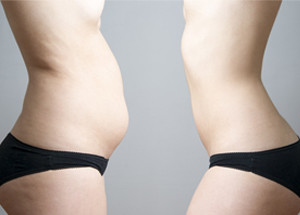The abdominal hernia is a pathologic tear or hole in the abdominal wall where internal tissues or part of the intestines push through this weakened area.
In our clinic abdominal, inguinal and umbilical hernia operations are performed with the use of tissue adhesive glue for synthetic mesh fixation.
Types of abdominal hernia:
- Femoral
- Inguinal
- Umbilical
- Epigastric
- Post-operative
The most common symptoms of abdominal hernia:
- Flexible bulge, usually located in the navel, groin or scar. Symptoms worsen usually during coughing, exertion or after defecating
- Stomach pain – similar to the pain associated with peptic ulcer
Over the years untreated hernia may grow, and its symptoms become more severe. This increases the risk of intestinal entrapment, which is a serious complication.
Patients often underestimate the problems with hernia, treating it more as an aesthetic defect, rather than a health problem. Nothing could be further from the truth! At any time, it can lead to intestinal entrapment, when only prompt surgical intervention saves live.
Unfortunately, the only way to cure hernia is a surgery.
Currently there are two methods of surgical treatment:
- 1. Traditional treatment (open), that can be performed with or without using artificial materials (i.e. mesh).
When dealing with small hernias (up to 5 cm) it is enough to remove hernia and sew the edges. With large hernias like those located in the upper abdomen it is necessary to place a synthetic mesh, which helps to close the gap in the operated area.
The most important thing is to strengthen the weakened abdominal wall. During this procedure, the surgeon tightens muscles, fascia and ligaments and puts on strong sutures. When the tissue loss is major, special mesh is implanted in the abdominal wall- which protects against recurrence of symptoms. Since the recovery period depends on the scope of the operation – often it is possible to get out of bed right on the next day. If there are no complications, patients are being discharged home usually after 1 to 3 days. Sometimes – if the hernia is really tiny – the treatment may be performed under local anesthesia, which allow patients to leave the clinic in the evening on the same day.
- 2. Laparoscopic hernia repair (closed).
This method has its supporters and opponents. The former believe that patients recover faster, because the surgical wound is small. Opponents argue however, that the laparoscope does not allow for precise attachment of the mesh , so there may be recurrences.
In our clinic we are performing only open operations.
The main postoperative recommendations:
After returning home, for first several weeks after surgery patients should prevent constipations (avoid certain foods that may cause gas or constipation, and apply a ban on the consumption of carbonated beverages). Moreover for the first three months patients should also avoid physical effort, especially lifting. Last but not least: it is recommended to put on a healthy lifestyle- that is to monitor the right weight and exercise to strengthen the abdominal muscles.









